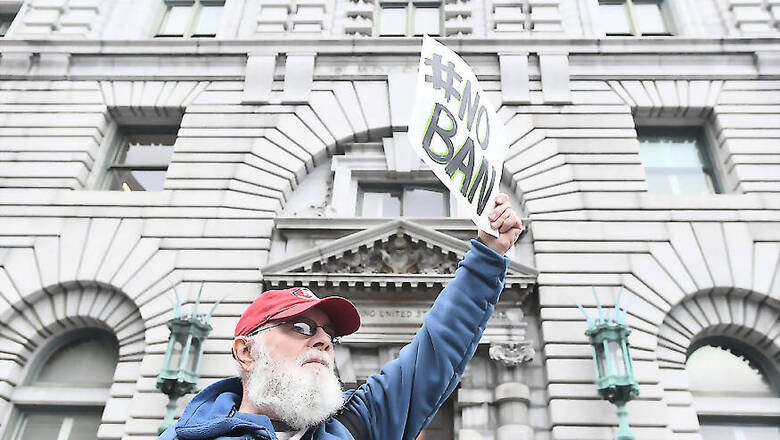
views
Washington: Now that President Donald Trump's travel ban has the Supreme Court's blessing, the fate of people in the seven already designated countries appears dire when it comes to their chances of coming to the United States.
So just how many people are we talking about?
While it's difficult to pin down who may or may not intend to visit, study or even become an immigrant to America, the most recent data available from the US State Department provides a window into ballpark figures.
During the 2017 fiscal year, the government issued about 87,000 "non-immigrant" visas from the seven nations affected by the administration's travel ban. Those include people ranging from tourists to students to those doing business in the United States (There were 9.7 million such visas issued worldwide during the fiscal year).
While much of the attention has focused on the ban's aim at Muslim-majority nations, the largest contingent of non-immigrant visas actually went to Venezuela. In fact, Venezuela had nearly twice as many visas as all the other countries combined.
Here are the individual countries broken down:
Iran — 19,801
North Korea — 55
Syria — 5,411
Libya — 1,552
Yemen — 2,919
Somalia — 276
Venezuela — 56,720
The picture is quite different for those seeking to immigrate.
Of about 20,000 immigrant visas granted in fiscal year 2017 to those coming from the seven countries, the largest contingents are actually from Iran and Yemen, State Department records show. Venezuela is in the middle of the pack, roughly the same as those from Syria.
Iran — 6,643
North Korea — 3
Syria — 2,551
Libya — 458
Yemen — 5,419
Somalia — 1,791
Venezuela — 2,909
The total number of immigrant visas worldwide by the US was about 560,000 during that period, so the seven countries still make up just a fraction of the total.
How will the travel ban play in November's election?
The already overheated politics of immigration after the family separations at the southern border are sure to be intensified even more after Tuesday's Supreme Court decision upholding the travel ban.
Heading into November, with control of the House in the balance, it's still too early to know how the travel ban itself will play into electoral politics. But a newly emboldened Trump, combined with increased anger on the left in the wake of the Supreme Court ruling, is a volatile combination.
We can observe some interesting dynamics, though, that help explain why the nation remains so bitterly divided on the immigration issue, and could complicate efforts for Democrats to press their case in Trump country headed into the fall.
If one were to look, House district by House district, at where Trump won in 2016 compared to Hillary Clinton, the map would look a lot like this:
But those aren't the presidential results. It's the breakdown of what portion of each congressional district is made up of foreign-born residents. (For the purposes of this analysis, it includes those born in all countries outside the United States.)
There are only 65 districts out of 435 where more than a quarter of their populations are foreign-born, according to the US Census Bureau's 2016 estimates. And huge swaths of the nation's geography have House districts with less than 1 out of 10
people born elsewhere.
By contrast, the members of Congress who have larger proportions of constituents born outside the United States are concentrated along the coasts, the southern border and in urban and suburban enclaves that dot the map around many American cities.
In other words, there's a distinct divide between large stretches of Trump country that supported the President and likely expect their congressional representatives to do the same, and areas more favorable to Democrats where foreign-born residents are more likely to be located.
This isn't necessarily a big surprise. But Democrats advocating for immigrants could face a difficult road in areas where people from foreign lands are few and far between, and the native-born population is already apprehensive about their way of life slipping away. It was, after all, just those groups of voters Trump won over in 2016. Trump's rhetoric about immigrants
"invading" the country could resonate in House districts filled with people who already responded to his call the first time, and who may be energized by immigration even if they have grown weary of Trump's personal foibles while in office.
Immigration becoming "the" issue in November could very well push voters toward their political corners, as much as it could offer a way for one party to make inroads on the other. For Democrats looking to flip vulnerable districts, they face a map that shows the risky bet ahead in putting immigration center stage.


















Comments
0 comment